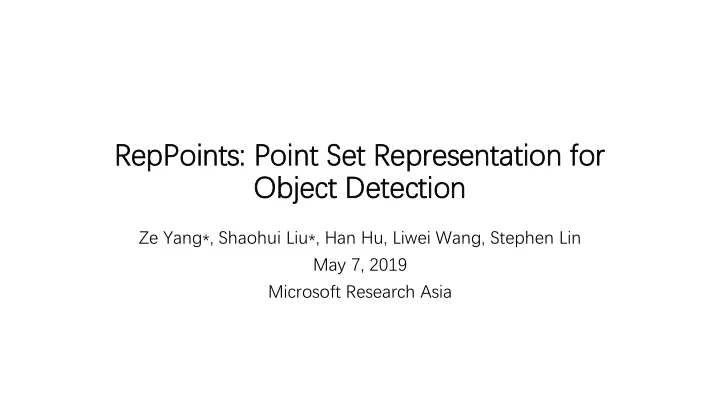

Rep epPo Points ints: : Po Poin int Set et Rep epres esenta entatio tion n for Ob Obje ject De Detec ectio tion Ze Yang*, Shaohui Liu*, Han Hu, Liwei Wang, Stephen Lin May 7, 2019 Microsoft Research Asia
Ov Over erview view • Review of modern object detection pipelines • RepPoints: bounding box -> point set representation • RPDet: an anchor-free object detector based on RepPoints • More discussion • interpretable deformation modeling • extending RepPoints: denser (seg) and finer target (correspondence) • regression vs. discrimination
Review of modern object detection pipelines RPN design in Faster R-CNN RoI feature extraction in Fast R-CNN Bounding boxes are used as anchors, proposals and final predictions.
Bound ndin ing boxes s are use sed as s anchors, s, proposa sals ls and fi final l predictio ions. ns. Bounding box has several advantages: - Easy to be annotated - Friendly for feature extraction - Consistent with common metrics (bbox IoU)
Bounding box also has limitations: - Insensitive to object shape and pose (coarse localization lack of geometric information) -> lower localization capability - Distractive background content and informative foreground content included -> degraded feature and lower recognition capability
RepPoints: Point Set Representation Bounding box vs. RepPoints
Learning Representative Points (RepPoints)
RepPoints: Point Set Representation
RPDet: an anchor-free object detector based on RepPoints
Bounding box vs. RepPoints
Studies on assigner, supervision and anchors for RepPoints
System level comparison
Discussion: some thoughts on RepPoints
Discussion A: Interpretable Deformation Modeling Deformable Convolutional Networks [2] Only using recognition feedback in an implicit manner & Lacking geometric interpretation on the learned offset.
Discussion A: Interpretable Deformation Modeling RepPoints: deformation modeling with explicit geometric interpretation.
Discussion B. Extending RepPoints: Denser and Finer Zhu et al. Flow-guided feature aggregation. Zhang et al. Pose-guided image generation, project at Upenn. Related Work: Deformation modeling for frame-to-frame correspondence in videos.
Discussion B. Extending RepPoints: Denser and Finer • Possible direction for extension: dense object perception. Segmentation (From Zhou et al. ExtremeNet) Semantic Correspondence (From Novotny et al. AnchorNet) Bottleneck: to design effective and efficient guidance on RepPoints.
Discussion C. Regression vs. Classification Another bottleneck: the localization ability of regression methods are lower than classification methods. [6] discrimination vs. [7] regression regression vs. discrimination : occupancy networks [8] e.g. 3D reconstruction: reg has higher resolution e.g. Object Tracking: reg is more efficient Regression is relatively more efficient and does not need predefined proposals, while classifying each pixel is more suitable for accurate localization. Combining regression with classification can potentially reduce time complexity and number of proposals.
Thanks! b1ueber2y@gmail.com [1] Ze Yang, Shaohui Liu, Han Hu, Liwei Wang, Stephen Lin. RepPoints: Point Set Representation for Object Detection. arxiv preprint arxiv: 1904.11490. [2] Jifeng Dai, Haozhi Qi, Yuwen Xiong, Yi Li, Guodong Zhang, Han Hu, Yichen Wei. Deformable Convolutional Networks. In ICCV 2017. [3] Xizhou Zhu, Yujie Wang, Jifeng Dai, Lu Yuan, Yichen Wei. Flow-Guided Feature Aggregation for Video Object Detection. In ICCV 2017. [4] Xingyi Zhou, Jiacheng Zhuo, Philipp Krähenbühl . Bottom-up Object Detection by Grouping Extreme and Center Points. In CVPR 2019. [5] David Novotny, Diane Larlus, Andrea Vedaldi. AnchorNet: A Weakly Supervised Network to Learn Geometry- sensitive Features For Semantic Matching. In CVPR 2017. [6] Luca Bertinetto, Jack Valmadre , João F. Henriques, Andrea Vedaldi, Philip H. S. Torr. Fully-Convolutional Siamese Networks for Object Tracking. In CVPR 2017. [7] David Held, Sebastian Thrun, Silvio Savarese. Learning to Track at 100 FPS with Deep Regression Networks. In ECCV 2016. [8] Lars Mescheder, Michael Oechsle, Michael Niemeyer, Sebastian Nowozin, Andreas Geiger. Occupancy Networks: Learning 3D Reconstruction in Function Space. In CVPR 2019.
Recommend
More recommend